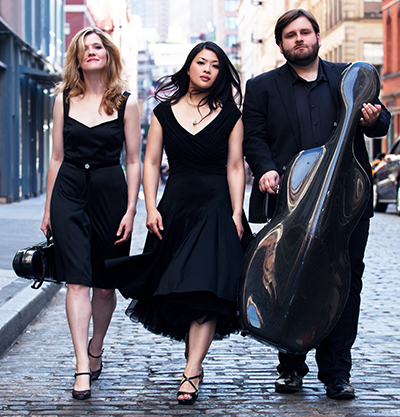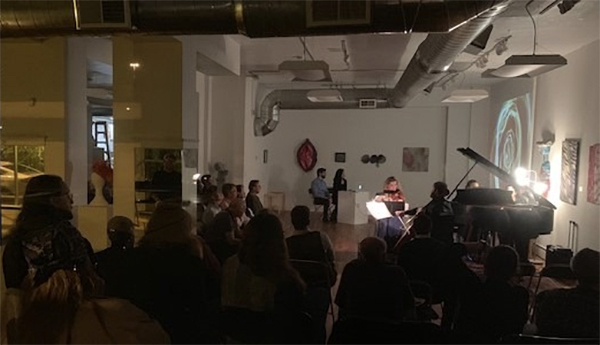by Nicholas Stevens
“We like to call this program The 1.8%,” declared Neave Trio violinist Anna Williams to a bustling room of listeners at Collinwood’s Praxis Fiber Workshop last week. That figure comes from a survey conducted by staff of the Baltimore Symphony Orchestra, who found that only 1.8% of all music programmed by America’s major orchestras in a recent season was by female composers. The trio aims to showcase what so many audiences have been missing. Like others who have mined this vein, the Neave has struck gold.
All four works on the program, performed as part of Underground Classical’s 2019 series, featured the same piano trio instrumentation — yet five artists took to the front of Praxis’s gallery space on Saturday, June 15. Multimedia designer Bing Lin and installation artist Andrew Ringler contributed live, abstract visual projections, which seemed to respond to the Trio’s sound at some moments and to run automatically at others.
Cécile Chaminade’s glorious Trio in g opened like floodgates. The surging energy that Williams, cellist Mikhail Veselov, and pianist Eri Nakamura established from the first notes carried through a thrillingly unsettled first movement. The second, featuring meaty solos for both string players, shared both the grandeur and the decadence that emerge in so much music of Chaminade’s era, albeit seldom mixed so effectively. The visual display matched the music best in the fluttering third movement, as points of light cascaded like droplets in a fountain. The fourth revealed the Neave Trio’s superpower: closing sections in which the end of the piece is treated not as a box to check, but as a thrill ride.
Nakamura played the ear-catching first chords of Amy Beach’s Trio in a as solid, upward-pointing structures, like lift bridges paused mid-rise. Soon thereafter, for the first of a handful of times, the group’s louder volumes overwhelmed the small, hard-walled room. Impressively tuned octaves for Williams and Veselov introduced a second movement laced with humor, and a hint of ragtime helped propel yet another impeccably-handled finale.

Cinematic swirls dominate “Pale Yellow,” the first movement of Jennifer Higdon’s Trio. Though Williams soared in high passages, Higdon’s string writing gave her and Veselov little room for interpretation. Thrumming piano and energetic bowing aside, “Fiery Red,” the second movement, offered little catharsis. Many of the earlier compositions surpassed this one in adventurousness. Therein lies the issue with expecting living composers to make up for classical programming imbalances. Women composers of the past wrote music that is often just as distinct and gripping as that of their male contemporaries. Some, such as Chaminade and Beach, were justly famous in their own time. Biased assessments in intervening decades have contributed to today’s unsustainable programming tilt. Hats off to the Neave Trio for making these composers’ excellence clear through spot-on, viscerally exciting readings.
Published on ClevelandClassical.com June 24, 2019.
Click here for a printable copy of this article




